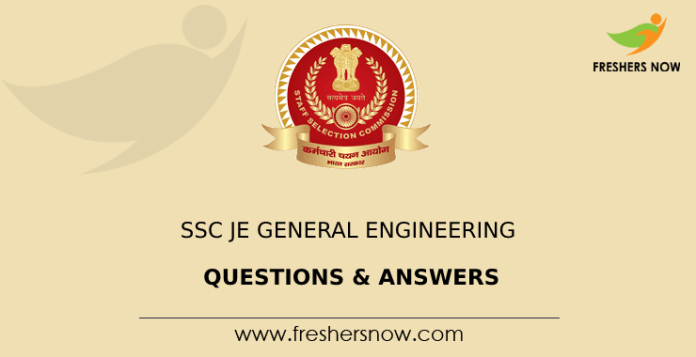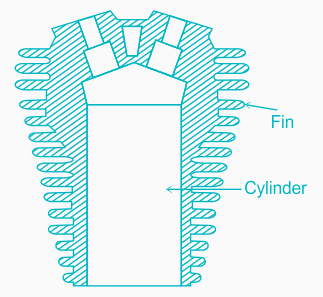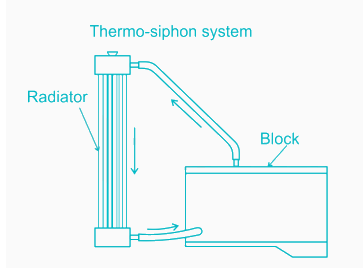
SSC JE General Engineering Questions & Answers: Are you preparing to participate in the SSC JE Exam and searching for SSC JE General Engineering Questions & Answers? If so, you’ve come to the right place. Here, we provide SSC JE General Engineering Questions & Answers in a quiz format, available in English. By attempting this quiz, you can effectively prepare for the SSC JE Exam and assess your knowledge level. So, take the quiz below and gauge your expertise.
★★ SSC JE CE Mock Tests ★★
★★ SSC JE ME Mock Tests ★★
★★ SSC JE EE Mock Tests ★★
SSC JE General Engineering Questions and Answers
Attempting the SSC JE General Engineering Quiz, as provided below, can be immensely helpful for you in familiarizing yourself with the types of questions asked in the exam. This quiz covers General Engineering topics in civil & structural, electrical, and mechanical disciplines that are relevant to the SSC JE Exam.
1. The number of possible inversions for a mechanism with 10 numbers of links will be:
A) 5
B) 0
C) 2
D) 10
E) None of these
Answer: D
Explanation:
Inversion:
- If one of the links is fixed in a kinematic chain, it is called a mechanism. So, we can obtain as many mechanisms as the number of links (n inversions from a kinematic chain having ‘n’ number of links) in a kinematic chain.
- This method of obtaining different mechanisms by fixing different links in a kinematic chain is known as inversion of the mechanism.
- In This question as there are 10 links, hence there will be 10 number of possible inversions.
- In the process of inversion, the relative motions of the links of the mechanisms produced remain unchanged.
2. Air-cooled engine’s efficiency is _______ than/as a water-cooled engine for the same power rating.
A) same
B) more
C) less
D) more or less depends upon operation
E) None of these
Answer: B
Explanation:
Air-cooled IC engine: In an air-cooled system a current of air is made to flow past the outside of the cylinder barrel, the outer surface area of which has been considerably increased by providing the fins. This method will increase the rate of cooling.

The temperature of the fin decreases from its root to its tip. The heat generated due to combustion in the engine cylinder will be conducted to the fins through the wall of the cylinder. The air is blown over the fins. Air takes the heat away by convection. Convection plays a major role in heat transfer, not radiation.
Water-cooled Engines: Two types of water-cooling systems are used
1. Thermo-siphon system:
In this system, no pump is used for water circulation. Water circulation is obtained due to the difference in the densities of hot and cold water. Water absorbs the heat and rises up in the block and goes to the radiator’s top side. Water is cooled in the radiator and then again goes to the water jacket in the engine. This system is simple, but the rate of cooling is very slow.

3. What is the primary function of a transformer in an electrical circuit?
A) To generate electricity
B) To store electricity
C) To step up or step down voltage
D) To control current flow
Answer: C) To step up or step down voltage
Explanation: Transformers are used to either increase (step up) or decrease (step down) the voltage in an electrical circuit, facilitating efficient power transmission and distribution.
4. Which material is commonly used in reinforced concrete to enhance its tensile strength?
A) Steel
B) Aluminum
C) Copper
D) Iron
Answer: A) Steel
Explanation: Reinforced concrete is a combination of concrete and steel, where steel provides the necessary tensile strength to withstand forces that concrete alone cannot handle.
5. Which law of thermodynamics states that energy cannot be created nor destroyed, only transferred or transformed?
A) Zeroth Law
B) First Law
C) Second Law
D) Third Law
Answer: B) First Law
Explanation: The First Law of Thermodynamics, also known as the Law of Energy Conservation, states that energy is conserved in any energy transfer or transformation process.
6. What is the purpose of a camshaft in an internal combustion engine?
A) To regulate fuel flow
B) To control the air intake
C) To convert heat to mechanical energy
D) To open and close engine valves
Answer: D) To open and close engine valves
Explanation: The camshaft is responsible for controlling the opening and closing of engine valves, allowing fuel-air mixture intake and exhaust gases expulsion.
7. Which type of welding process utilizes a consumable electrode coated with flux?
A) Gas Metal Arc Welding (GMAW)
B) Shielded Metal Arc Welding (SMAW)
C) Gas Tungsten Arc Welding (GTAW)
D) Submerged Arc Welding (SAW)
Answer: B) Shielded Metal Arc Welding (SMAW)
Explanation: In Shielded Metal Arc Welding, a flux-coated electrode is used to create a weld, and the flux provides protection from atmospheric contamination.
8. In a three-phase electrical system, what is the phase angle difference between consecutive phases?
A) 60 degrees
B) 90 degrees
C) 120 degrees
D) 180 degrees
Answer: C) 120 degrees
Explanation: In a three-phase electrical system, the phase angle difference between consecutive phases is 120 degrees, leading to a balanced distribution of power.
9. What type of stress causes a material to lengthen or compress along its axis without any change in shape?
A) Tensile stress
B) Compressive stress
C) Shear stress
D) Bending stress
Answer: A) Tensile stress
Explanation: Tensile stress occurs when a material is subjected to forces pulling it apart, leading to elongation along its axis.
10. The process of heat treatment that involves heating and then gradually cooling a metal to alter its properties is called:
A) Annealing
B) Tempering
C) Quenching
D) Forging
Answer: A) Annealing
Explanation: Annealing is a heat treatment process that involves heating a metal to a specific temperature and then slowly cooling it to improve its ductility and reduce internal stresses.
11. What is the SI unit of power?
A) Watts
B) Volts
C) Amperes
D) Ohms
Answer: A) Watts
Explanation: Power is measured in Watts (W) in the International System of Units (SI).
12. What is the purpose of a flywheel in a mechanical system?
A) To control fluid flow
B) To store energy
C) To measure torque
D) To increase rotational speed
Answer: B) To store energy
Explanation: A flywheel stores kinetic energy and helps to maintain a steady rotational speed in a mechanical system, reducing variations in output and providing smoother operation.



